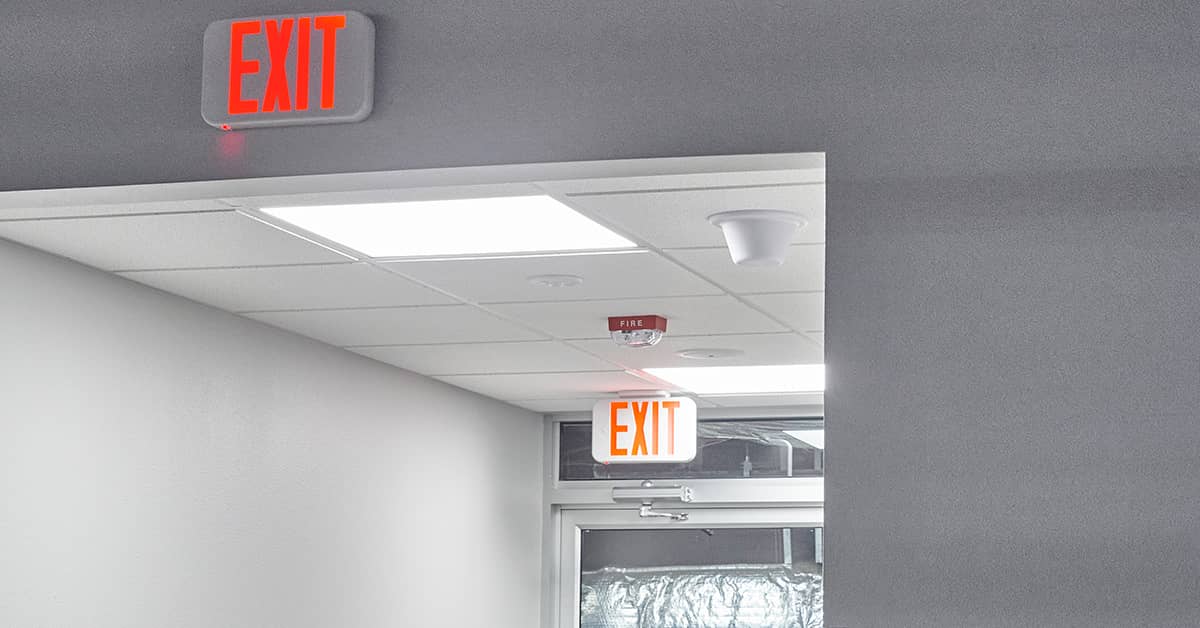Get out of here! Common exit route questions
Date Posted: 01/09/2023

OSHA commonly cites employers for blocking exit routes or locking exit doors. Parking a forklift in front of an exit door could cost lives during an emergency. Blocking exits, however, is just one potential violation. Below are answers to common questions our experts receive.
What’s the minimum exit route width?
OSHA specifies a minimum of 28 inches in 1910.36(g)(2). However, this applies to existing buildings. The National Fire Protection Association (NFPA) specifies 36 inches for new construction, and local fire codes might adopt that standard. In addition, 1910.36(f) says that the capacity of an exit route must be adequate. Depending on the number of people, an exit route may need to be wider than 28 inches (or wider than 36 inches).
Must exit signs be self-illuminating?
No, OSHA does not require self-lighting signs. However, 1910.37(b)(6) requires illuminating exit signs to at least five foot-candles. Ambient or directional lighting could suffice, such as emergency lights that come on during a power loss.
Make sure exit signs remain properly illuminated when the building is occupied, even if the power goes out. Self-lighted signs ensure this, but with proper lighting, plastic or metal exit signs can work.
How should we test emergency lighting?
According to NFPA 101® Life Safety Code® Section 7.9.3, you should test emergency lights monthly for at least 30 seconds, and annually for 90 minutes to verify that they would stay on during a long-term situation like sheltering in place during a tornado. NFPA also recommends keeping records of inspections and tests.
How much light is required along exit routes?
OSHA does not list a light level along an exit path. Instead, 1910.37(b)(1) simply requires that exit routes be adequately lighted so that an employee with normal vision can see along the route.
How many exit signs do we need?
In addition to signs over exit doors, you may need directional signs pointing to the nearest exit. These signs are required when the direction to the nearest exit is not apparent.
Not every door or room requires a sign, if the exit is obvious. For example, bathrooms may need emergency lighting, but don’t require an exit sign over the door.
How many exits do we need?
Most buildings or areas with an occupancy over 50 require at least two exits. However, you may need more to ensure safe and rapid evacuation. NFPA 101® Life Safety Code® lists the maximum travel distance to the nearest exit. Distances vary with building type, but some typical examples (assuming overhead sprinklers) include:
- 200 feet for most building types
- 250 feet for industrial buildings
- 400 feet for ordinary storage warehouses
Although secondary exits could be further away, the nearest exit from any point must be within those limits. These distances may affect the number of exits required in larger buildings. Note that travel distances change with other factors. For example, storing flammable liquids may reduce the travel distance to 100 feet or less.
What is the safe distance for an assembly area?
Employers should identify a safe location for headcount, but no specific distance could apply in all situations. Employees of a retail store might only need to travel a couple hundred feet, but employees at a chemical manufacturing facility likely need to get much further away.
How Safety Management Suite Can Help
Every employer needs an Emergency Action Plan, and not just for evacuations. The purpose of an EAP is to organize employee actions during likely emergencies, from fire to severe weather to chemical releases. A poorly developed plan could cause confusion, injury, and property damage. The Written Plans tool in the J. J. Keller® SAFETY MANAGEMENT SUITE offers a template that can be modified as needed, along with many other plan templates.
E-mail Newsletter
Sign up to receive the weekly EHS Insider email newsletter for safety articles, news headlines, regulatory alerts, industry events, webcasts, and more.